| Author |
Message |
|
Jose Albovias
|
 Posted: Wed 13 Jun, 2007 9:56 am Post subject: Scottish Dirk: Is this real, a reproduction, or a composite? Posted: Wed 13 Jun, 2007 9:56 am Post subject: Scottish Dirk: Is this real, a reproduction, or a composite? |
 |
|
Greetings. Been a while since I was last on here. I have the opportunity to get this Scottish dirk. Overall: 16 inches
I have examined it in hand and the knotwork carving is deep. The pommel cap is brass and appears old and worn (you can see the lines where it was soldered together and beginning to come apart). The pommel nut is recent and machined, the "ferrule" between the wood and blade I believe later too. The hilt at the haunces has what looks like 2 pins each where they were once covered by brass shoulders. Inside the hilt the hole starts rectangular and ends at the top round. Also on the knotwork - only in one place is there a place that has trace evidence of incised lines (near the blade), the rest is smooth, although it is possible that they have been worn smooth.
The blade is 11.75 inches and comes from a cut down sword of European manufacture. In some of the back notches there is black and brown rust and patina. The blade may have been cleaned in the past. On the back of the blade there is a somewhat false edge rounded (and some of the notches are also worn). The tang has black patina and a rectangular tapering shape ending in a screw. Black patina still exists on other parts of the blade as well.
Could this be an antique dirk or a reproduction? If antique, what period would you guess? Any and all feedback is welcome (please!).........
Jose
 Attachment: 21.07 KB Attachment: 21.07 KB

 Attachment: 35.77 KB Attachment: 35.77 KB
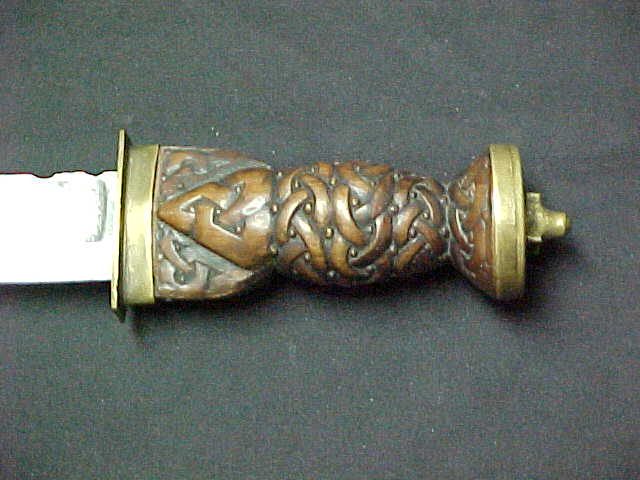
 Attachment: 37.41 KB Attachment: 37.41 KB
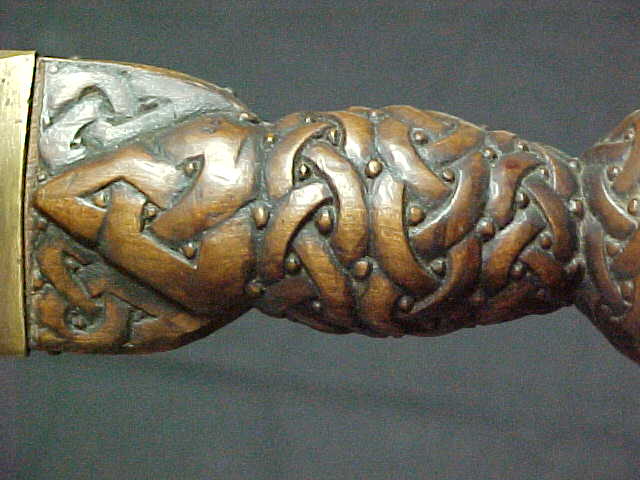
 Attachment: 32.59 KB Attachment: 32.59 KB
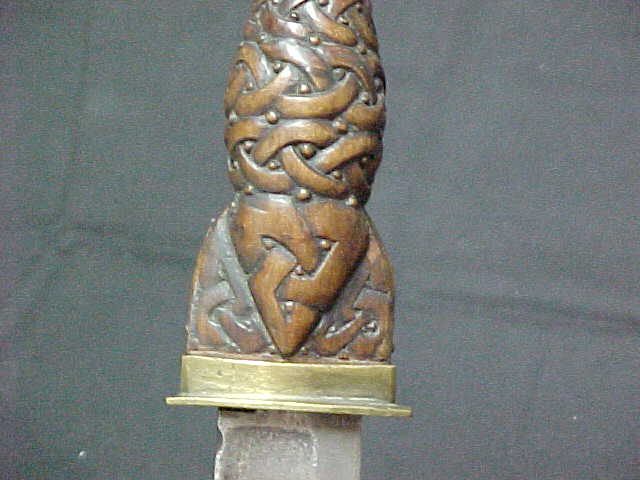
|
|
  |
 |
|
Jose Albovias
|
 Posted: Wed 13 Jun, 2007 10:02 am Post subject: Posted: Wed 13 Jun, 2007 10:02 am Post subject: |
 |
|
Here are more pictures for your perusal.........
 Attachment: 29.55 KB Attachment: 29.55 KB

 Attachment: 34.99 KB Attachment: 34.99 KB
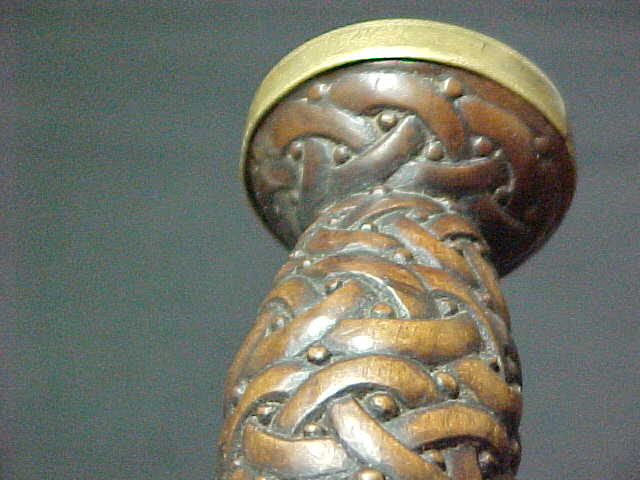
 Attachment: 22.65 KB Attachment: 22.65 KB
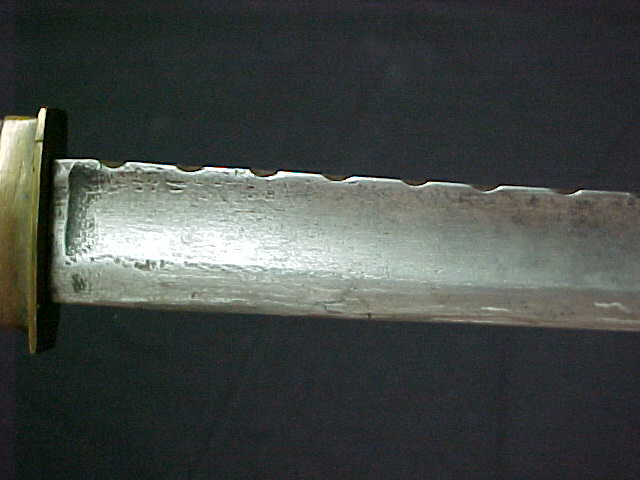
|
|
  |
 |
|
Jose Albovias
|
 Posted: Wed 13 Jun, 2007 10:04 am Post subject: Posted: Wed 13 Jun, 2007 10:04 am Post subject: |
 |
|
And here are some more pictures........
 Attachment: 25.54 KB Attachment: 25.54 KB
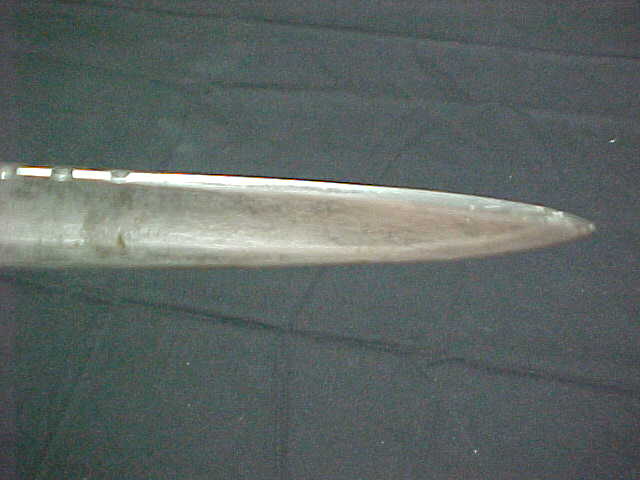
 Attachment: 26.22 KB Attachment: 26.22 KB
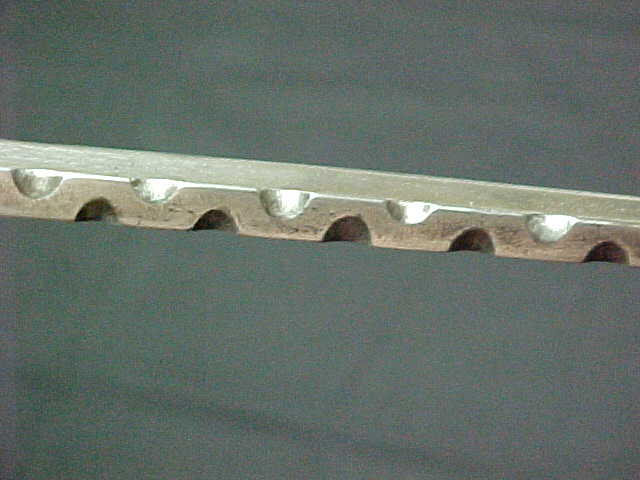
|
|
  |
 |
|
Walter Stockwell
|
 Posted: Wed 13 Jun, 2007 11:52 am Post subject: Posted: Wed 13 Jun, 2007 11:52 am Post subject: |
 |
|
My guess is 20th century.
There shouldn't be the brass "hilt", "guard", whatever that is. The joint between the blade and handle shouldn't be flat.
The pommel cap seems overly large compared to antiques I've seen.
The carving pattern is good. I've seen just about that exact pattern on antiques. But the quality of the carving isn't there. The knotwork looks squared, not rounded.
The blade used looks suspicious. It's not the type of broadsword or backsword you'd expect to see used. The filework on the back looks a lot like modern sgian dubh filework.
The proportions of handle to blade are surprising good. Most people who make a Scottish dirk make the handle too long. This looks to be in the 4" range, which matches historical examples.
It's doesn't look 18th century. It's not a Victorian 19th century example, so I vote 20th.
Is it a reproduction, or someone who wanted to make a dirk? I dunno.
Walter
www.stockwellknives.com
|
|
   |
 |
|
Lin Robinson
|
 Posted: Wed 13 Jun, 2007 12:47 pm Post subject: Posted: Wed 13 Jun, 2007 12:47 pm Post subject: |
 |
|
I agree with Walter. In the case of the hilt, the overall lines are there, but the quality of execution is not. The carved studs in the interlace usually indicate an older dirk, as these carvings were replaced by brass and silver nails in later dirks, but here it just seems like the maker was copying what he knew to be an older style. Again, the idea is good, the execution is not.
You had mentioned the addition of the "ferrule" or squared off plate at the joint between the guard and the blade. That was certainly not something found on antiques and I am mystified why a modern maker would add it to an otherwise pretty authentic-looking dirk. The pommel cap looks OK to me as far as size goes, but the construction quality is not very good, nor does there appear to be any decoration.
I don't think it is an antique either. Someone with a pretty good eye for architecture but limited ability to pull off the details probably made this for his personal use and it has now wound up in the hands of someone who probably thinks it is old and is trying to sell it for an antique. What sort of price are they asking and does the seller offer any documented history to go along with it?
Lin Robinson
"The best thing in life is to crush your enemies, see them driven before you and hear the lamentation of their women." Conan the Barbarian, 1982
|
|
  |
 |
Sean Flynt

|
 Posted: Wed 13 Jun, 2007 1:19 pm Post subject: Posted: Wed 13 Jun, 2007 1:19 pm Post subject: |
 |
|
Looks like a cut-down military saber blade to me. A 19th c. saber, new or now, would be worth more than a reproduction dirk of this quality, so I would guess that it's not too recently manufactured but not Victorian/Edwardian either. Maybe first half of the 20th c. Not much patina on the hilt (easily forged) so I don't think the maker was trying to forge an antique. I would say that although it technically is an antique, it is merely "in the style" of an 18th c. dirk.
-Sean
Author of the Little Hammer novel
https://www.amazon.com/Little-Hammer-Sean-Flynt/dp/B08XN7HZ82/ref=sr_1_1?dchild=1&keywords=little+hammer+book&qid=1627482034&sr=8-1
|
|
   |
 |
|
Walter Stockwell
|
 Posted: Thu 14 Jun, 2007 11:39 am Post subject: Posted: Thu 14 Jun, 2007 11:39 am Post subject: |
 |
|
Plate 65 in John Wallace's Scottish Swords and Dirks shows a dirk with a similar guard. He says that dirk is from the "third quarter of the eighteenth century." That dirk was in silver with better detailing. Wallace mentions that the crossguard is a "curious feature" but also seen on an example in Drummond and a painting from 1714.
Interesting dirk, but still looks 20th century to me.
Walter
www.stockwellknives.com
|
|
   |
 |
|
Lin Robinson
|
 Posted: Thu 14 Jun, 2007 11:50 am Post subject: Posted: Thu 14 Jun, 2007 11:50 am Post subject: |
 |
|
| Walter Stockwell wrote: | Plate 65 in John Wallace's Scottish Swords and Dirks shows a dirk with a similar guard. He says that dirk is from the "third quarter of the eighteenth century." That dirk was in silver with better detailing. Wallace mentions that the crossguard is a "curious feature" but also seen on an example in Drummond and a painting from 1714.
Interesting dirk, but still looks 20th century to me. |
I have both those books but did not look at them before replying. And, nothing about the one in the post looked familiar. I will certainly take a look when I get home tonight.
Thanks for the information.
Lin Robinson
"The best thing in life is to crush your enemies, see them driven before you and hear the lamentation of their women." Conan the Barbarian, 1982
|
|
  |
 |
Chad Arnow
myArmoury Team


|
 Posted: Thu 14 Jun, 2007 12:03 pm Post subject: Posted: Thu 14 Jun, 2007 12:03 pm Post subject: |
 |
|
Here are two more dirks with those strange guard things. Both are from Peter Finer's 1995 catalogue.
 Attachment: 37.67 KB Attachment: 37.67 KB
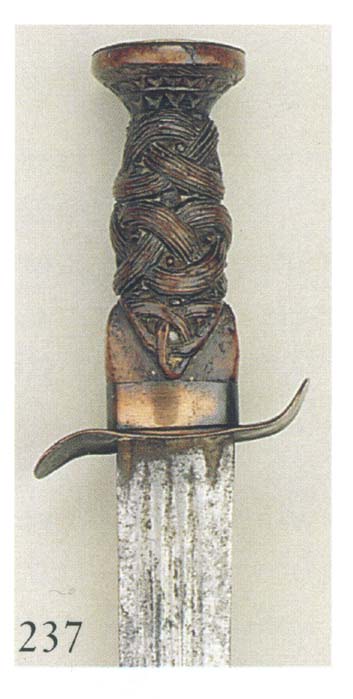
 Attachment: 38.07 KB Attachment: 38.07 KB
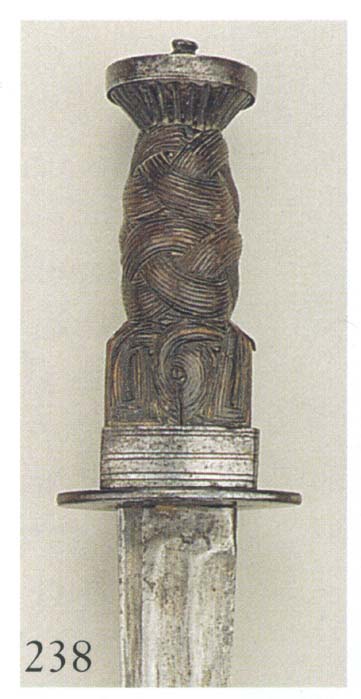

ChadA
http://chadarnow.com/
|
|
    |
 |
|
Jose Albovias
|
 Posted: Fri 15 Jun, 2007 10:37 am Post subject: Posted: Fri 15 Jun, 2007 10:37 am Post subject: |
 |
|
|
I am getting the impression that the consensus is this is a reproduction dirk with an early 20c European blade. I am not shocked by this. The detailed lines that should be on this piece in the wood are not there. The blade is later than I would have expected. And upon close inspection I believe that the brass at the base is a cruder later made piece.
|
|
  |
 |
|
Jose Albovias
|
 Posted: Sat 16 Jun, 2007 11:08 am Post subject: Posted: Sat 16 Jun, 2007 11:08 am Post subject: |
 |
|
Chad - those are wonderful pictures - never seen those before, though I have heard of their existence and have seen 2 other examples.
Here are some final pictures that may clear things up a bit.
Thank you.
 Attachment: 26.05 KB Attachment: 26.05 KB
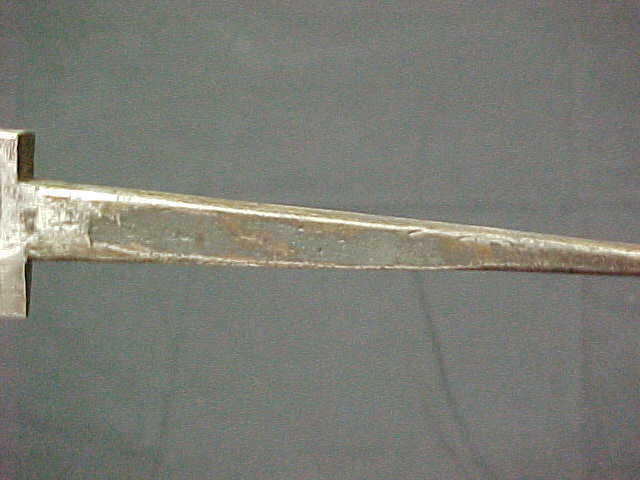
 Attachment: 27.11 KB Attachment: 27.11 KB
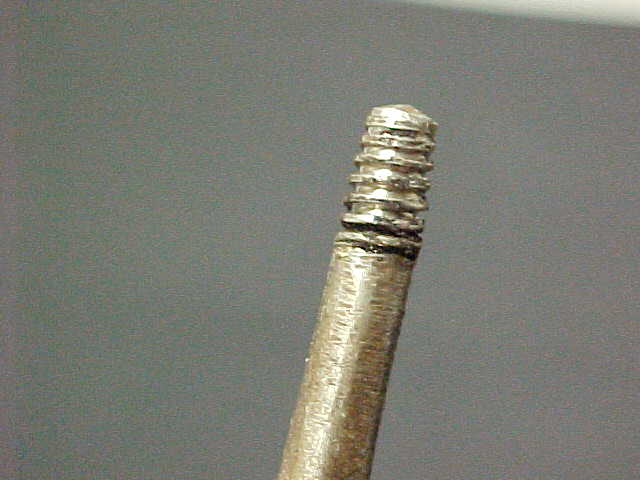
 Attachment: 32.75 KB Attachment: 32.75 KB

 Attachment: 28.55 KB Attachment: 28.55 KB

|
|
  |
 |
|
Jose Albovias
|
 Posted: Sat 16 Jun, 2007 11:10 am Post subject: Posted: Sat 16 Jun, 2007 11:10 am Post subject: |
 |
|
And one more time........
Again thank you all. 
 Attachment: 34.47 KB Attachment: 34.47 KB

 Attachment: 20.9 KB Attachment: 20.9 KB
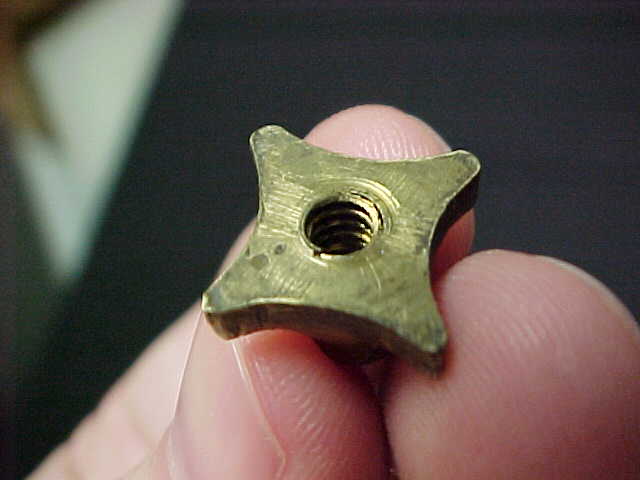
 Attachment: 18.64 KB Attachment: 18.64 KB
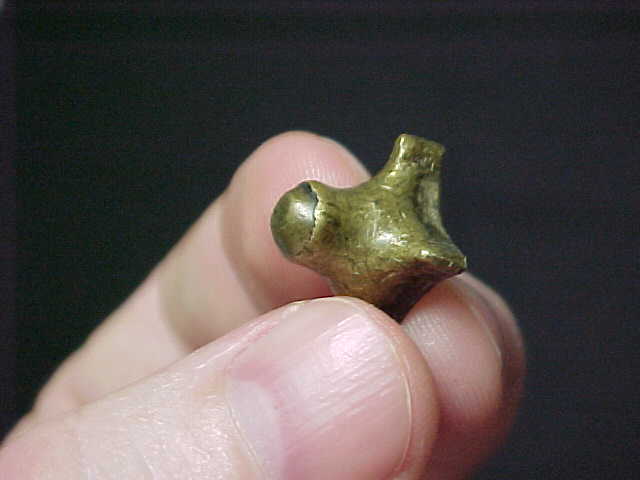
|
|
  |
 |
|
Walter Stockwell
|
 Posted: Sat 16 Jun, 2007 12:40 pm Post subject: Posted: Sat 16 Jun, 2007 12:40 pm Post subject: |
 |
|
I've had the chance to examine a number of the dirks in the collection of the National Museum of Scotland. None of them have a blade to tang transition like that one.
Walter
www.stockwellknives.com
|
|
   |
 |
Henrik Bjoern Boegh

Location: Agder, Norway Joined: 03 Mar 2004
Posts: 386
|
 Posted: Sat 16 Jun, 2007 6:30 pm Post subject: Posted: Sat 16 Jun, 2007 6:30 pm Post subject: |
 |
|
Walter, what would the tang on an original 18th century dirk-blade look like?
Jose,
If it isn't 18th century, it's still a lovely piece (in my eyes).
I don't think that all dirks would show the burned or carved detailed lines in the interlace patterns, and when used extensively dirks might be worn down so that the carving would look more squared than round. On some dirks from before the mid 18th century the brass or silver bands at the joint between handle and blade is more flat than curved, though not that common.
At first I thought the dirk might have been an 18th century one, but with the arguements in this thread, I've changed my mind...
Cheers,
Henrik
Constant and true.
|
|
  |
 |
|
Walter Stockwell
|
 Posted: Sun 17 Jun, 2007 12:31 pm Post subject: Posted: Sun 17 Jun, 2007 12:31 pm Post subject: |
 |
|
The forged dirks (the ones purpose forged to be dirks) looked like this:

The NMS had a number of dirks with damaged handles so you could clearly see this shape.
The ones made from cut down swords are a bit trickier. I didn't see ones with the same kind of damage where you could see this transition. However, they generally had the same type of hilt (often with the curved hilt/blade interface). There would be no need to have the sort of squared off blade transition shown on this one. I don't remember any with a ricasso, like this one.
Thinking about this more, this makes me think even more it is modern. Look at old swords -- there is no fussy fitting of the guard to the blade. No one would make a sword like that. The square transition creates stress risers -- a sword would be in danger of snapping at that transition. This looks like the maker filed into the this to square it off so it would fit just right against the square guard. Modern knife makers worry a great deal about making a perfect fit between the blade and guard, just like this shows.
The interesting thing to me though is that this doesn't look to me like someone trying to make a "reproduction" or fool someone by antiquing a modern blade. It strikes me as an honest attempt to make a Scottish dirk. Maybe someone in the army wanted a "real" dirk, not just the ceremonial type dirks made in the 20th century. It would be interesting to try to ID what type of sword was used to make this. It doesn't look like the usual Scottish backswords.
Walter
www.stockwellknives.com
|
|
   |
 |
|
Jose Albovias
|
 Posted: Mon 18 Jun, 2007 10:02 am Post subject: Posted: Mon 18 Jun, 2007 10:02 am Post subject: |
 |
|
Thank you so much folks. Very helpful and enlightening. Will take all of this into consideration.
Again many thanks and "lang mai yu lum reek!"
|
|
  |
 |
|
Lin Robinson
|
 Posted: Mon 18 Jun, 2007 12:44 pm Post subject: Posted: Mon 18 Jun, 2007 12:44 pm Post subject: |
 |
|
| Walter Stockwell wrote: | Plate 65 in John Wallace's Scottish Swords and Dirks shows a dirk with a similar guard. He says that dirk is from the "third quarter of the eighteenth century." That dirk was in silver with better detailing. Wallace mentions that the crossguard is a "curious feature" but also seen on an example in Drummond and a painting from 1714.
Interesting dirk, but still looks 20th century to me. |
I checked my copies of both and sure enough, there they are. I am embarrassed because I have had both of those books for years, thought I had perused them carefully and yet I missed something. In my defense, the guards do not stand out in the photos. Still, I should have noticed them.
Interesting subject, but the more detailed pictures that Jose provided prove, at least to me, that this is a later reproduction, not a genuine antique. With a little more attention to detail and a bit more skill, the maker might have pulled it off. He/she does have a good eye for the architecture.
Lin Robinson
"The best thing in life is to crush your enemies, see them driven before you and hear the lamentation of their women." Conan the Barbarian, 1982
|
|
  |
 |
|
Walter Stockwell
|
 Posted: Tue 19 Jun, 2007 12:53 am Post subject: Posted: Tue 19 Jun, 2007 12:53 am Post subject: |
 |
|
| Lin Robinson wrote: |
I checked my copies of both and sure enough, there they are. I am embarrassed because I have had both of those books for years, thought I had perused them carefully and yet I missed something. In my defense, the guards do not stand out in the photos. Still, I should have noticed them.
Interesting subject, but the more detailed pictures that Jose provided prove, at least to me, that this is a later reproduction, not a genuine antique. With a little more attention to detail and a bit more skill, the maker might have pulled it off. He/she does have a good eye for the architecture. |
I only noticed it because someone on Swordforum said "Formans book has several with similar hilts and guards dated to the Jacobite era." I'd never seen one like this so I hit the books. 
So do you think this is a reproduction trying to look antique, or an actual dirk someone made? To my mind this would be a poor "fake" - using a non-usual sword type for the blade and a very unusual guard. Both of these things attract attention and skepticism.
Walter
www.stockwellknives.com
|
|
   |
 |
|
Lin Robinson
|
 Posted: Tue 19 Jun, 2007 7:05 am Post subject: Posted: Tue 19 Jun, 2007 7:05 am Post subject: |
 |
|
| Walter Stockwell wrote: |
I only noticed it because someone on Swordforum said "Formans book has several with similar hilts and guards dated to the Jacobite era." I'd never seen one like this so I hit the books. 
So do you think this is a reproduction trying to look antique, or an actual dirk someone made? To my mind this would be a poor "fake" - using a non-usual sword type for the blade and a very unusual guard. Both of these things attract attention and skepticism. |
Walter...
To me it looks as if someone set out to make their idea of a late 17th c. dirk, using available materials, i.e. a (broken?) sword blade, some brass and hardwood for the handle. As I mentioned earlier, the maker has a pretty good eye for the overall style and architecture of what he/she was trying to reproduce, but failed in the execution. The maker may have seen dirks with the unusual guard in a book and thought it was a more common style. Most people who try to fake something, be it a gun, dirk or something else, do not pick out a rare or unusual piece to duplicate. Anything that is rare is likely to receive more scrutiny than an every day piece and anyone trying to fake something for profit will not want close examination. I think it was an honest attempt to produce a replica dirk and nothing more. Jose said that he had the opportunity to acquire the dirk but he did not mention price. However, since it was presented to him as a Scottish dirk without reference to it being a reproduction - hence his question on the forum - we can assume that the person offering it to him thinks it is genuine. That may have been true for much of the dirk's history but I do not think intent of the maker was to produce a fake antique.
Lin Robinson
"The best thing in life is to crush your enemies, see them driven before you and hear the lamentation of their women." Conan the Barbarian, 1982
|
|
  |
 |
|
|

